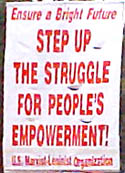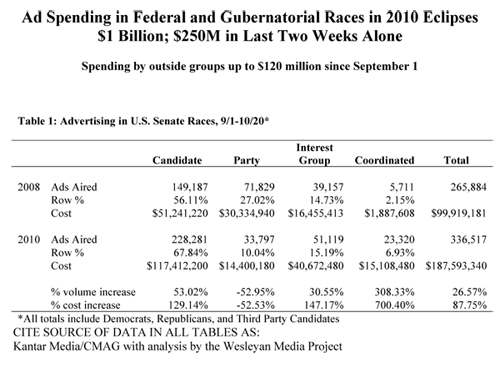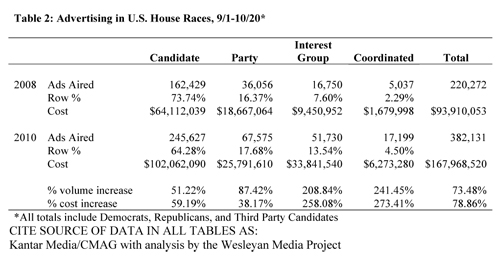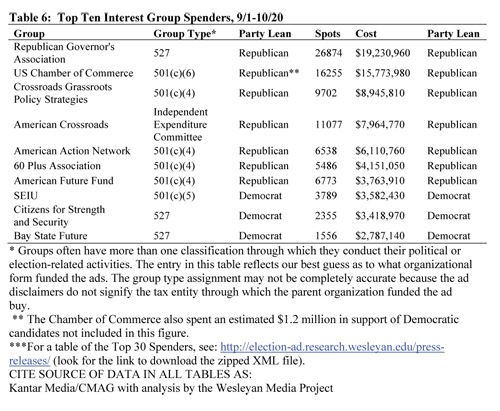Demand Information on the Issues and No Negative Ads
•
Fund the Process Not the Candidates and Parties
•
More Than $1 Billion Spent in Ads for Senate, House and Gubernatorial Races
Oppose Voter Disenfranchisement• Prisoner Disenfranchisement Plagues U.S. Elections• Defending the Asian American Vote • MALDEF Wins Ninth Circuit Decision Overturning Arizona Voter Registration Law
Demand Information on the Issues and No Negative Ads
Fund the Process Not the Candidates and Parties
A main feature of U.S. elections is the massive amounts of money spent,
and the character of the advertising as negative, often racist, and serving to disinform the public, not inform them. This election is taking place at a time of continuing wars abroad, economic crisis and major crises on issues impacting society as a whole, such as unemployment, poverty and destruction of the environment. These problems and solutions for them are what people want discussed and debated as part of the elections. A program of solutions and identifying the candidates that best represent those solutions is content needed for modern elections. Yet 2010 sees negative ads, with their character assassination and dirty smears at higher levels than ever. Since September, negative ads represent 50 percent of ads by Democrats and 65 percent of those by Republicans. The ads are not geared toward informing the public and putting them in a position to calmly and rationally work out what is needed to move society forward. Indeed this is what is kept out of the election process at all costs.
The aim of the massive advertising and its negative, petty and “promises made to be broken” content is to disinform the public, to generate disgust and rejection of politics — when politics and being political is urgently needed to solve problems. The public — as a polity, the body politic of society, defending the interests of society, its collectives and individuals — is to be torn apart, its form disintegrated so as to preserve the rule of the rich.
This year almost $4 billion has been spent on campaigning. This includes large increases in the number of ads, up about 27 percent from 2008, a presidential year, and their cost, up by almost 90 percent. The large majority of campaign spending is done by the candidates, together with their parties and what are called “coordinated ads,” which combine funds from candidates and Party campaign committees. As an example, from September 1 to October 20, the candidates and parties together accounted for about 85 percent of ad spending. Outside interest groups accounted for about 15 percent.
The thoroughly rotten character of this election, together with it being one of the most expensive at a time when government claims "there is no money" for social services, is serving to further anger the public while leaving people feeling there is no alternative. At a time when the full energies and ingenuity of the people are required to solve problems, we face an electoral process designed to keep the people out of power. Yet the reality is that the productive forces in the U.S. are modern and highly developed. They require a democracy that is also modern and highly developed. Such a democracy can be created by empowering the people to govern and decide and stepping up organizing now to accomplish this.
An important and immediate means to change the situation is to demand that an independent national electoral commission, funded with public dollars, organize elections and fund the process. No party, candidate or outside funding would be permitted. Instead, information concerning the problems to be solved, the programs of candidates to solve them, the interests served by various proposals, etc. would be the content of election campaigns provided by such a commission. It would also make certain that every candidate would have equal time and opportunity to present and elaborate their program to the public. The process would provide space for information, debate and ability to identify which candidates and proposals best represent the needs of the people. By publicly funding the process and gearing it towards informing the public, elections would contribute to solving problems rather than serving to disinform and disorganize the public while wasting billions of dollars. It also opens space for working people to elect and be elected.
The recognition by many of the need to put ordinary working people in power was revealed in a recent poll. People were asked, if they had the option to vote to get rid of the entire Congress and start over with new people, would they do so? About 65 percent of likely voters said yes. About half also said people randomly selected from the phone book would do a better job than the current Congress. While the poll is being promoted as a means to discredit Congress and use anger with Congress to make elected governance the problem, the response shows something different. It shows that many recognize that ordinary working people, which are what the majority of those randomly selected from the phone book would be, need to govern. Funding the process with the aim of informing and uniting the public on a program of solutions to the problems we face is a step in this direction of politically empowering the people.
[TOP]
More Than $1 Billion Spent in Ads for Senate, House and Gubernatorial Races
Wesleyan Media Project, Oct. 27, 2010
As of October 20, spending on just advertising in Senate, House and gubernatorial races has eclipsed $1 billion, a historic figure by any measure. Almost $620 million of that spending has been since September 1, and $250 million was in the past two weeks alone. As a point of comparison, roughly $220 million was spent on advertising between January 1 and September 15. That means in the last two weeks alone, spending overtook the first nine and a half months of the year. Year-to-date spending is almost 50 percent greater in House races (from almost $142 million in 2008 to more than $210 million today) and has almost doubled in Senate races compared to 2008 (from $157.5 million to $314 million). [Estimates for total spending by candidates, parties and outside groups for the 2010 elections is currently about $4 billion and rising, the highest for a mid-term election — VOR ed.]
“Almost any way you look at it, the advertising is up — and way up — this year,” said Travis Ridout, co-director of the Wesleyan Media Project and associate professor of political science at Washington State University. “That’s true for spending and the volume of ads, it is true for House and Senate races, and it is true whether one is looking at candidate or interest group spending,” he explained.
Table 1 shows spending in Senate races for the same September 1 to October 20 time period in both 2008 and 2010. The only category of ad spending that is down from 2008 is party spending, but if one takes into account-coordinated expenditures with the campaigns, party spending is flat. In the two week period from October 7 to October 20, an estimated $70 million was spent on ads in Senate races.

Table 2 shows the same information for U.S. House races. Increases in spending and ad volumes are just as dramatic as in the Senate races, with total ad volume up 73 percent over 2008 and ad total ad spending up 79 percent. In the two-week period between October 7 and October 20, an estimated $69 million was spent on advertising in U.S. House races.

Interest group activity has especially increased in House races – by more than 200 percent when measured through airings and more than 250 percent when measured through spending. For the Senate, “As a proportion of all airings, interest groups account for roughly the same amount of the air war as they did last cycle,” said Michael Franz, co-director of the Project and associate professor of government at Bowdoin College.
The nation’s most expensive Senate races are found in California, Illinois, Florida and Pennsylvania where more than $15 million has been spent on advertising since September 1. In terms of the total volume of ads, however, Nevada, Wisconsin and Florida have the nation’s most intense U.S. Senate races. Democrats and Republicans are fairly well matched in terms of ad volume in many of the states, though the Republican has more than a 2 to 1 advantage in ad volume over the Democrat in both Missouri and Florida’s three-way Senate race. The table also includes the percentage of total airings that were sponsored by interest groups. In Missouri, Colorado, and Nevada, outside groups have aired about 30 percent of all pro-candidate ads. In California and Pennsylvania the number is past 20 percent.
The nation’s most expensive House races are found in Michigan’s 7th district (held by Democrat Mark Schauer), Nevada’s 3rd district (held by Democrat Dina Titus) and Virginia’s fifth district (held by Democrat Tom Perriello). All three representatives are serving their first terms in office. In Michigan 7, outside groups have sponsored nearly 31 percent of the 11,000 ads since September 1. In four other races, outside groups have sponsored more than 1 in every 5 ads.
For gubernatorial races, California continues to outpace all others weighing in at nearly $60 million since September 1. The three-way Florida contest follows with nearly $36 million. Texas clocks in at almost $25 million, with New York, Massachusetts, Ohio, Wisconsin, Pennsylvania and Maryland all at eight figures. Notably, in the Wisconsin race, interest groups have sponsored more than 43 percent of the 27,000 airings, which accounts for a larger share of the advertising than either individual candidate.
The table below shows the top independent groups that are spending on political advertising in support of or opposition to a candidate. Republican-leaning groups dominate the top of the list, which is headed by the Republican Governor’s Association. This group is followed closely by the U.S. Chamber of Commerce, which has spent an estimated $15.7 million since September 1 in support of Republican candidates and an estimated $1.2 million in support of Democratic candidates. All told, outside groups have spent $120 million on advertising for candidates since September 1. The majority of that money ($85 million) has benefited Republicans.
“Particularly noteworthy is the fact that 6 out of the top 10 interest group spenders are non-profit groups that do not have to disclose their donors, and were we to exclude the Republican Governor’s Association, it would be 7 of the top 10 as number 11 is Americans for Job Security,” said Erika Franklin Fowler, co-director of the Project and assistant professor of government at Wesleyan University. “That is nearly $40 million dollars of advertising activity in top races for which the public will be unable to track the source.”

[TOP]
Senate, House and Governor's Races
All Federal House of Representative seats, thirty-seven Senate seats and thirty-seven governorships are up for election on November 2, 2010. There are also elections for state legislatures and numerous ballot measures.
Senate
Senators serve six year terms, with about one third up for election every two years. Thirty-seven Senate seats are up for election in 2010, 19 held by Democrats and 18 by Republicans. Fourteen of these seats are open, meaning there is no incumbent competing in the election. Six of these seats are Democratic and eight Republican.
Three of the races are open because the incumbent lost his or her primary election: Sens. Bob Bennett, R-Utah, Lisa Murkowski, R-Alaska, and Arlen Specter, D-Pa. Murkowski is running as a write-in candidate.
The party breakdown in the Senate currently is 57 Democrats, 41 Republicans and two independents who caucus with the Democrats.
House
All 435 House seats are up for election as House representatives serve only two year terms. About 100 of the races this year are considered competitive though it is likely that many incumbents will still win. The large majority of seats, about 335, are considered "fixed" before the election occurs, meaning the voting district is designed to guarantee a win by either a Democratic or Republican incumbent. A party must win 218 seats to get a majority. The party breakdown in the House currently is 255 Democrats, 178 Republicans and two vacancies. Republicans need to win 40 more seats and lose none to win control of the House.
Four House incumbents lost their primary elections: Reps. Alan Mollohan, D-W.Va., Parker Griffith, R-Ala., Bob Inglis, R-S.C., and Carolyn Cheeks Kilpatrick, D-Mich.
Governors
Thirty-seven state governorships are up for election, including those in major states like California, New York, Florida, Pennsylvania and Texas. Currently, 19 Governorships are held by Democrats and 18 by Republicans. Twenty-four of the races are open, with no incumbent— 12 Democratic and 12 Republican.
Fifteen of the races are open because the incumbent is barred from running again by term limitations. One race is open because the incumbent, Gov. Jim Gibbons, R-Nev., lost his primary race.
The party breakdown on governorships is 26 Democrats and 24 Republicans.
State legislatures
A total of 6,115 out of 7,382 state legislative seats are up for election in 46 states.
Currently 27 state governments are controlled by Democrats and 14 by Republicans. Eight state governments are divided between the two parties. One state, Nebraska, has a nonpartisan state senate.
Ballot measures
For the November 2, 2010 general election ballot 160 ballot questions, or propositions, have been certified in 37 states. In some states, like California, if the proposition passes, it becomes law. In others it is not binding.
Five political topics dominate the 2010 ballot, and 3 of the 5 most popular topics each relate to fiscal policy. The "Big 5" topics on the 2010 ballot are taxes, administration of government, elections and campaigns, bond issues and state budgets. The number of 2010 ballot measures relating to fiscal topics is an increase of about 13% over the number of such measures on the 2008 ballot.
The 2010 ballot includes fewer social issues (such as abortion, marriage, immigration, gambling) than has been the case in most recent years, although one of the most widely-remarked measures on the ballot, California's Proposition 19, relates to legalizing marijuana. The federal government has threatened to intervene in California to enforce federal laws making possession of marijuana a crime, if the proposition passes.
For more information on ballot questions see http://ballotpedia.org/wiki/index.php/2010_ballot_measures
[TOP]
Prisoner Disenfranchisement
Plagues U.S. Elections
The problem of disenfranchisement of prisoners continues to be a major means for the government to exclude large numbers of African Americans and other national minorities from voting. The U.S. criminal unjustice system is one of the most racist in the world. It has long been used to imprison national minority youth in disproportionate numbers, while also boasting one of the highest rates of incarceration in the world. Coupled with this is the fact that all but two states (Maine and Vermont) do not allow prisoners, regardless of the crime, to vote. Many also disenfranchise people not only while they are imprisoned but also while on probation, and some states do so for life. The vast majority of those imprisoned were convicted of nonviolent crimes, like possession of marijuana, shoplifting or writing a bad check. Yet they are barred from voting, even after leaving prison.
The following is an indication of state disenfranchisement laws:
• 48 states and the District of Columbia prohibit inmates from voting while incarcerated for a felony offense.
• Only two states — Maine and Vermont — permit inmates to vote.
• 35 states prohibit people on parole from voting and 30 of these states exclude people on probation as well.
• Two states deny the right to vote to all people with felony convictions, even after they have completed their sentences. Nine others disenfranchise certain categories of ex-offenders and/or permit application for restoration of rights for specified offenses after a waiting period (e.g., five years in Delaware and Wyoming, and two years in Nebraska).
• Each state has developed its own process of restoring voting rights to ex-offenders but most of these restoration processes are so cumbersome that few ex-offenders are able to take advantage of them.
Impact of Felony Disenfranchisement
• An estimated 5.3 million Americans, or one in forty-one adults, have currently or permanently lost their voting rights as a result of a felony conviction.
• African American men are disenfranchised at a rate seven times the national average. Black men make up only about 8 percent of the general population but now comprise more than one-third of the disenfranchised population. At the current rate and pattern of incarceration, Human Rights Watch estimates that three in ten of the next generation of black men will be disenfranchised at some point in their lifetime and, in states with the most restrictive laws, 40 percent of black men are likely to permanently lose their right to vote.
• 2.1 million disenfranchised people are ex-offenders who have completed their sentences.
• Nearly 5 million people were barred from voting in the November 2004 election due to a felony conviction — almost 2 million of them were African Americans. The state of Florida had an estimated 960,000 ex-prisoners who were blocked from voting in the 2004 presidential election. It is estimated that even larger numbers nation wide were not eligible to vote in the 2010 elections.
In 1870, the 15th Amendment to the United States Constitution extended the right to vote to former slaves. In the decades that followed, a variety of Jim Crow laws were used to systematically block the participation of the new black electorate. Now 140 years later, mass incarceration and felony disenfranchisement remain as mechanisms to deny African Americans the right to vote.
[TOP]
Defending the Asian American Vote
The Asian American Legal Defense and Education Fund (AALDEF) will conduct an Asian American exit poll, Monitors November 2 elections in New York, Pennsylvania, Massachusetts, Georgia, and Texas. It has also established a Multilingual Voter Hotline: 800.966.5946. Those facing discrimination at the polls are encouraged to call.
AALDEF will also conduct a nonpartisan multilingual exit poll in eight languages to get a snapshot of Asian American voting preferences.
Margaret Fung, AALDEF executive director, said, “With so much at stake in the 2010 midterm elections, we want to ensure that all eligible Asian Americans are able to exercise their right to vote.”
She noted that in addition to congressional races, the outcome of several governors’ races could affect the redistricting process as well as national policy debates in the next few years.
AALDEF, a 36-year old New York-based national civil rights organization, said it will dispatch 400 attorneys, law students and community volunteers to over 50 poll sites in New York, Pennsylvania, Massachusetts, Georgia, and Texas to document voting problems in the November 2 elections.
Poll Monitoring
AALDEF will monitor over 50 poll sites for compliance with the Voting Rights Act and the Help America Vote Act.
Volunteer attorneys will observe the provision of Asian-language ballots, interpreters, signs and voting materials, which are required in certain districts; the application of voter identification requirements; and whether provisional ballots are offered to individuals whose names do not appear on voter lists.
Settlements in New York City, Philadelphia, and Boston for past violations of the language assistance provisions of the Voting Rights Act will also be monitored.
Glenn D. Magpantay, AALDEF Democracy Program Director said, “In the 2008 Presidential Election, Asian Americans had to overcome numerous obstacles to exercise their right to vote. AALDEF volunteers identified interpreter shortages and poll workers who made hostile and racist remarks about Asian American voters. AALDEF will guard against the disenfranchisement of new citizens and limited English proficient voters.”
Multilingual Exit Poll
AALDEF will conduct a nonpartisan exit poll of Asian American voters in eight languages: English, Chinese, Korean, Vietnamese, Khmer, Bengali, Punjabi, and Urdu. Voters will be asked about their candidate preferences in races for Governor, U.S. Senate, and U.S. House of Representatives.
Asian Americans will be asked whether they are first-time voters, the top issues influencing their vote, party enrollment, use of Asian-language voting assistance, and whether they encountered specific problems at the polls.
The AALDEF exit poll reveals vital information about Asian American voting patterns that is often overlooked in mainstream voter surveys. In the 2008 Presidential election, AALDEF polled 16,665 Asian American voters in 11 states – the largest poll of its kind in the nation.
AALDEF has conducted exit polls of Asian American voters in every major election since 1988, noting the steadily increasing numbers of new citizen and first-time voters.
Multilingual Voter Hotline:
Multilingual volunteers will be at poll sites to take complaints from voters about election irregularities and barriers to voting. Voters can also report Election Day problems by calling AALDEF’s toll-free Election Day Hotline at 800-966-5946 or by e-mail at votingcomplaints@aaldef.org.
Immigrant Justice Vote Protection Project
Reform Immigration FOR America – Michigan is organizing to make sure that everyone who has the right to vote is able to cast a ballot. A wave of voter suppression is sweeping the country:
• Ads telling Latinos NOT to vote were pulled from the air recently in the Southwest, and in Texas; Tea Party-backed groups are intimidating early voters in African-American and Latino precincts. It is so serious that the Department of Justice is investigating.
We do not want any irregularities here in Michigan where there have been organized efforts to discourage minority and immigrant voters from participating. Please volunteer with the Alliance for Immigrants Rights and ACCESS on Tuesday, November 2nd to Protect the Vote.
We need lawyers and law students in the Detroit area who would be willing to do one of the following:
1) Be on-site at our call center in Dearborn in case civil rights complaints are phoned into our bilingual hotline
2) Patrol certain targeted polling places throughout Detroit and Dearborn
3) Be on call at your place of work if you are unable to commit to a election protection shift.
[TOP]
MALDEF Wins Ninth Circuit Decision Overturning Arizona Voter Registration Law
The Mexican American Legal Defense and Education Fund (MALDAF) welcomed the Ninth Circuit’s ruling in Gonzalez v. State of Arizona, striking down an Arizona law that restricted voter registration. MALDEF had challenged the 2004 law, also known as Proposition 200, as unconstitutional and in violation of federal law because the law forced voters to meet onerous new identification requirements at the polls and imposed unnecessary paperwork requirements on those seeking to register to vote. The ruling concluded that Prop 200′s voter registration provision is unconstitutional because it is inconsistent with federal law guaranteeing uniform voter registration procedures throughout the U.S. In its decision, the Ninth Circuit explained that the National Voter Registration Act, a comprehensive law enacted by Congress to combat discriminatory and onerous state voter registration schemes, supersedes Prop 200′s additional documentation requirements. The Ninth Circuit concluded that the district court did not err in upholding the polling place voter identification provisions of Prop 200.
In response to the ruling, MALDEF President and General Counsel Thomas A. Saenz remarked, “This welcome decision, auspiciously coming one week before a critical national election, stands as a warning to anyone who seeks to deter or prevent voter participation — whether through overreaching legislation as in Arizona or through more informal attempts at intimidation.”
Nina Perales, National Senior Counsel and lead counsel in the case, stated, “Today’s ruling is an important vindication of federal law. No longer will thousands of U.S. citizens in Arizona be rejected for voter registration by an unconstitutional scheme that conflicts with federal law.”
MALDEF filed this case on behalf of individual voters and voter registration applicants as well as the following organizations: Southwest Voter Registration Education Project, Valle del Sol, Friendly House, Chicanos Por La Causa, the Arizona Hispanic Community Forum, ACORN, Project Vote, and Common Cause.
[TOP]
